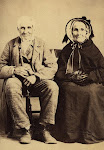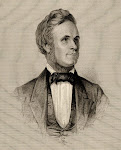The Church of Jesus Christ of Latter-day Saints went through something of a northward expansion in 1900. Settlers were sent as far away as Canada to expand the church into unsettled country. In the winter of 1899-1900 the church leaders began to call families to settle Wyoming’s upper Shoshone River Valley called “The Big Horn”. One hundred families were to be called with A. O. Woodruff as president and Byron Session as Vice President and General Manager. Byron Sessions had moved to Woodruff from Bountiful and set up a small empire. With his three wives, one of which was Ellen Cox, daughter of John Cox, he hired Joseph Hyrum Neville to build the biggest house in town south of Woodruff which later became known as “The Brick.” One of the few prosperous citizens of Woodruff, he was called as a member of the Stake Presidency in 1898 and was thus serving when he was called to sell out and move to the Big Horn Valley.
“Headed for the Big Horn Basin: On Hundred families are on their way to settle in.” On Saturday April 21, 1900, a Deseret News article outlined the future for the Big Horn Pioneers: Beginning at Salt Lake City, Rich County, Idaho, Morgan and Evanston-wherever they now were living-they would travel to Kemmerer where Apostle Woodruff would travel by train to meet his ox team. Then, following the old Mormon Trail back for 100 miles, they would cross South Pass and turn due north to Burlington, a Mormon town of 400.
Once in the basin, they would camp and begin digging a 25 mile canal from the Shoshoni River. The canal was to be 15 feet wide at the bottom, 25 wide at ground level. After the canal was finished and water provided for crops, they would be free to build homes.
Apostle Woodruff reported that he had secured “a sturdy band of settlers, well equipped to undergo the hardships and perform the arduous labors incident to establishing a town in the wilds of an unsettled country.”
In an effort to find sturdy settlers, Byron Sessions looked around him. He has cities, farms and mills to build, and a 25 mile irrigation canal to dig which would link the Shoshone River to the settlements. He knew he had to have a genius with him to accomplish it. So he called Joseph Hyrum Neville to come with him. Joseph had been on a mission to the Sandwich Islands (Hawaii) and in 1899 was called on a second mission to England and changed to the Big Horn. Joseph seemed not to have complained. He was always up to a new challenge, and if his family swallowed hard at the call, he seems not to have wavered.
Families had intermarried in Woodruff until there was hardly a family which didn’t bid goodbye to loved ones as they gathered. Bryon, Scott and Edwin Sessions had married Annie Stiff Cox’s daughters Ellen and Agnes, and Joseph Hyrum Neville’s daughter Annie, which at least gave them some companionship. Many of these colonizers had been too recently through the difficult and almost primitive colonization of Woodruff, and they weren’t about to do it again. Having accumulated farm equipments, harnesses, feed and other goods necessary for setting up a city, they arranged to have those implements shipped by train through Ogden and up to Idaho Falls’ thereafter to Butte, Montana and then to Laurel, and finally to Bridger, Montana, the only train route northward. Then they sold out, loaded their wagons, and moved up north to meet their farm equipment.
Joseph and Byron Sessions left with their families in April for the rendezvous in Kemmerer. However, the rest of the Woodruff group who had not left in April gathered out in the fields near the Neville family homes south of Woodruff. On May 24, 1900, the whole town turned out to throng twenty wagons preparing to depart. It was a tearful day. Of the 48 citizens leaving, most of the families in town had at least one family member who was leaving, sons, daughters, brothers and sisters. Three hundred head of livestock no doubt added to the confusion. These people knew communication was poor. They weren’t sure when they would see their loved ones again. For the women, leaving their homes in Woodruff was traumatic. Ann Neville, wife of Joseph Hyrum, recorded the difficulty experienced by every woman who uprooted and left for the Big Horn.
“We got ready to go, sold a few things and left all our furniture except one chair and bedstead, but lost the chair, and shipped the bed and tent. Started about April 20th, and what a trip we had. It snowed for about a week and the roads were very bad and we had to make bridges and roads, but we were blessed with health. I drove a team and buggy most all the way. My son Leo drove a team and wagon so did Joseph. One night we camped near Little Wind River. We sent my boy Daniel to get a bucket of water. In a little while he come in dripping wet. He said the stream was so swift it took him and the bucket down stream, but he grabbed a willow and saved himself, but not the bucket. We were very thankful he was saved. Solon was 15 months old, and I had to carry him up all the steep hills. He would not let anybody else take him. How tired I got.
Ralph’s birthday was on the 21st of May. I shall never forget that day we had just crossed Green River, it was storming. People told us that lived close by that we should not cross, but our leader call us all together and we all knelt down to pray. When we got up President Sessions said, and others that felt it was all right to cross so we all got across in safety. They unharnessed the horses. It was no sooner done than the biggest clap of thunder I have ever heard in all my life was heard and lightening was so fierce that the horses reared and some broke loose; and the rain came down in great sheets, and the river rose in a short time and overflowed its banks. It stayed up a long time.
Ann recorded the events of that journey, and thus preserved a family treasure.
“Our daughter Annie Mae, was married just before we left Woodruff to Ed Sessions, so she was with us part of the time and helped me some. We used to be called mornings and nights to sing a hymn and pray. My husband used to call them with his coronet, the bugle call…and usually the dogs was the first to be there, and oh, they would set up and howl. My Leo had a Kodak. He took quite a few pictures.
The children all rode with me in the buggy. That is Nona, Daniel, Jabez, Ralph and Salon. Ralph had a good voice although he was so young and we would all sing and that helped. We drug a cart behind the buggy loaded with a big copper boiler loaded with cooking utensils and you should have heard the racket when we went a little fast. We arrived in the Big Horn about the 29th of May.
We passed some beautiful country we wished to stop in, but since we were called to the Big Horn, we did not want to stop until we got there. We were five weeks on the journey. Started in April 19th and arrived May 29th. I was disappointed when they said that was where we were going to stay. Well, I thought it was the worst place I had ever seen. There was not a green thing to be seen and even the cottonwood trees on the river had hardly any leaves on and the water did not taste good, but we had to make the best of it. We had been called by the authority of the Lord.”
Some trails may seem too hard. The uprooted families became homesick. Finally the canal was finished and their homes were built but it was a desolate place. What would grow so far north? Yet even for such fears there were answers. The colonists were to find that although some crops don’t thrive, poppies, tulips, climbing roses and a few other flowers sill brighten their lives. For all who are obedient there are compensations: blessings even in the face of hardship.
For Joseph Hyrum Neville, each new colonization was something of an adventure. He would go on to create a legend in Northern Wyoming. He taught Bryon Session to level the new canal, and then set up a blacksmith shop. Joseph and Ann ran a store for the railroad when it came through, and they had the first post office in their home. He surveyed and laid out the towns of Byron, Cowley and Penrose; and was a builder for the Basin County Courthouse. Eventually he went on to the Wyoming Legislature for which his picture still hangs in the Capital Building in Cheyenne where he so long ago had passed as a young man with his parents on a train. The Capitol Courthouse still displays maps he drew.
His renown was no less at home. After working on the Sidon Canal, still in use today, he helped build up much of Byron. He was interested in milling and when the Hatches came from Bountiful to build a mill, his son helped them and married one of their daughters. Always involved in machinery, he masterminded a steam boiler which in 1916 became a mill because of water power was a problem in the basin. He often hosted Buffalo Bill Cody for dinner at his home.
His family grew up and contributed to the development of Wyoming. He truly was an outstanding pioneer. And it seems they weren’t as isolated as they had feared. The railroad soon came in and telephones quickly followed. Occasionally family members would travel from Byron of from Woodruff and they would enjoy the family fellowship again. James and Elizabeth Smith occasionally made the trip to Byron and brightened their lives as they had those in Woodruff with the famous talking puppet show. Little things are the one that make the most difference in people’s lives.
Unable to finish his last term in the Legislature, Joseph died December 24, 1925. Although his medical bills left her in somewhat desperate circumstances, Ann’s main concern to the end of her life was that her children make temple covenants so their families could be together forever.
Saturday, October 27, 2012
Subscribe to:
Post Comments (Atom)









No comments:
Post a Comment